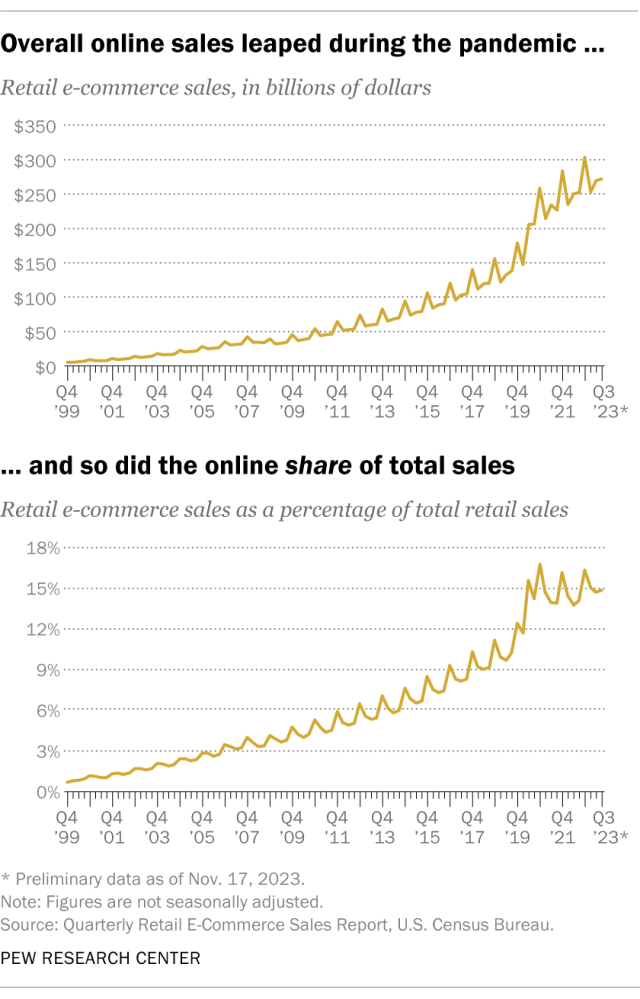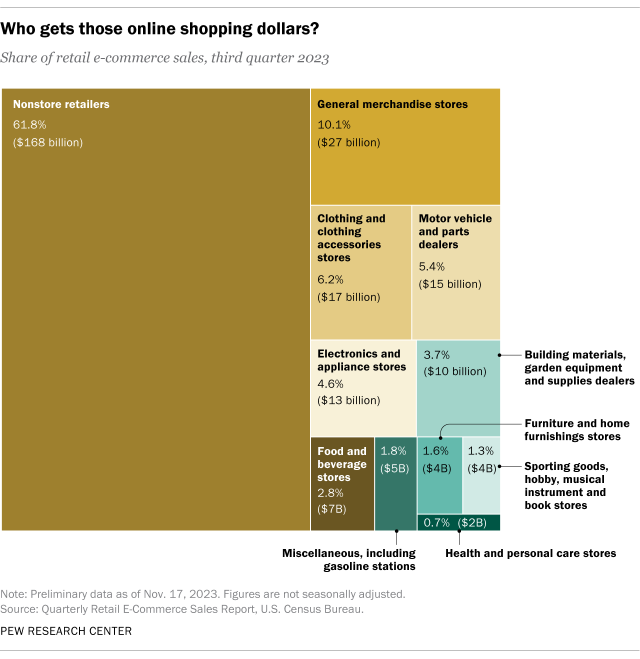
Thanksgiving – and, more specifically, Black Friday – is the semiofficial start of the holiday shopping season in the United States. And if history is any guide, a lot of this year’s holiday shopping will be done online, and not just on Cyber Monday.
Like retail sales generally, online shopping reliably surges in the fourth quarter of every year. In 2022, for example, online sales – or, as the U.S. Census Bureau calls them, “retail e-commerce sales” – totaled $303.1 billion in the October-December period. That was 23.4% higher than the quarterly average for the first nine months of the year, which was $245.6 billion. (Figures in this analysis are not adjusted to account for seasonal variations.)
But it’s not just the dollar volume of sales that peaks in the fourth quarter – the online share of all retail sales ticks higher at year’s end, too. In the fourth quarter of 2022, for instance, online sales accounted for 16.3% of all retail sales, compared with an average of 14.1% in the first three quarters.
The fourth quarter of 2023 could be another big one for online shopping. Through the first three quarters of the year, retail e-commerce totaled $793.7 billion, or 14.9% of all retail sales.
Related: For shopping, phones are common and influencers have become a factor – especially for young adults
As the 2023 holiday shopping season begins, Pew Research Center wanted to find out just how significant online sales are as a share of total retail sales in the United States.
The primary keeper of such data is the U.S. Census Bureau, which, since 2000, has produced a quarterly report on “retail e-commerce sales.” The estimates in that report are based on the same sample of 10,800 retail firms the Census Bureau uses for its Monthly Retail Trade Survey (MRTS). The MRTS sample is weighted and benchmarked to represent the full universe of more than 2 million retail firms.
It’s important to note that bars and restaurants are not considered retailers for the purposes of the bureau’s surveys. Online travel services, ticket sellers and financial-services brokers and dealers likewise are excluded from coverage.
This analysis uses data that has not been adjusted to account for seasonal variations. Figures for the third quarter of 2023 are preliminary, based on data released Nov. 17, 2023.
Online sales have grown over time
Between 2000 and 2020, growth in online sales followed a predictable pattern. The online share of retail sales jumped in the fourth quarter and then fell back, but not all the way to where it had been. Then it jumped again, to an even higher level, in the fourth quarter of the following year.

By such stepwise moves, the online share of total retail sales grew from 0.7% in the fourth quarter of 1999, when the U.S. Census Bureau began tracking online sales, to 12.4% in the fourth quarter of 2019.
The COVID-19 pandemic that swept the globe disrupted that pattern, at least temporarily, beginning in early 2020. With many physical stores shuttered and millions of Americans sheltering in their homes, online sales soared. In the second quarter of 2020, for instance, e-commerce sales totaled $205.3 billion, up 55% from the $132.3 billion recorded a year earlier. In the fourth quarter of 2020, e-commerce accounted for 16.7% of all retail sales, still the record-high share.
That share fell back as stores reopened and consumers gradually resumed their old shopping habits. But the e-commerce share of all retail sales has remained well above pre-pandemic levels, suggesting that the COVID-19 outbreak gave online shopping a lasting boost. In the fourth quarter of 2022, 16.3% of retail sales were online, compared with 16.1% in 2021.
Which retailers benefit most from online sales?
The retailers that are getting the highest share of online sales tend to be those without physical stores.
Nonstore retailers, as the Census Bureau calls them, took nearly 62% of all retail e-commerce sales in the third quarter of 2023, versus just over 59% a year earlier. E-commerce sales at nonstore retailers rose 12.4% year over year, faster than the online sales sector as a whole.
Among retailers that do have physical stores, online sales rose 8.7% at general merchandise stores, 5.1% at food and beverage stores, and 4.7% at health and personal care stores. But online sales fell 1.6% at electronics and appliance stores, 3.2% at motor vehicle and parts dealers, and 16.2% at furniture and home furnishings stores.

Where does Black Friday get its name?
For years, the claim circulated that Black Friday got its name because of its role in retailers’ profitability. The notion was that most retailers operated at a loss, or “in the red,” for most of the year and relied on holiday sales to become profitable, or “in the black.”
However, the actual origins appear to be more prosaic. Philadelphia police began calling the day after Thanksgiving “Black Friday” in the 1950s because the floods of holiday shoppers into downtown made their jobs extra difficult.



